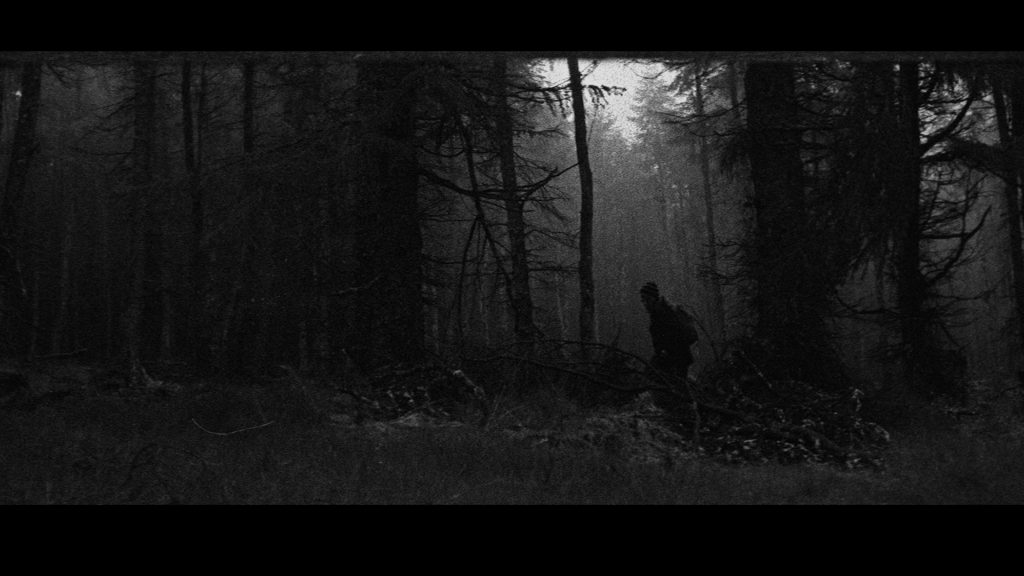Last month I wrote about a feature film by an artist, Luc Fowler’s All Divided Selves, and it was announced recently that it’s been shortlisted for the 2012 Turner Prize. I’m not sure but this may mark the first time a feature film has been nominated for the prize. Earlier this month I went again to the Institute for Contemporary Art in London to see another film by a British artist, Ben Rivers’ Two Years at Sea. A far more romantic and personal piece of art. Two Years at Sea is a portrait of Jake, a man who lives a lone, subsistence lifestyle in Aberdeenshire, Scotland.
It’s interesting to think about these works together because they are both narrative artworks but employ narrative in unique ways. Strictly speaking neither really has a narrative in the classical sense; Fowler’s film is a mashup of archival footage that loosely describes a portrait of a man very much engaged with society; Rivers’ film has no dialogue and amounts to a sequence of meditative images and the odd day to day doings of a woodland eccentric.
Essentially it is an hour and twenty minutes of Jake going about his daily existence, bathing, cooking, chopping wood, reading, looking through old photos picking through miscellaneous detritus, playing cassettes of Sitar music on the tape deck of a ruined Jeep. Subtle moments of magical realism start to creep in when at one point Jake falls asleep in a caravan which then slowly lifts itself aloft and settles precariously atop a stand of spruce trees. Later he almost ritualistically assembles a small raft and deploys it for a period of floating meditation. An eight minute period to be precise. A length for which Rivers would have had to modify his 16mm camera in order to get the shot without a break. The shot is gripping, but one is also left alone with one’s thoughts as the ripples on the water fade to a glassy mirror. This is one of two such shots in the film. The second one is the last shot, Jake’s face by firelight, with an imperceptibly slow fade to black. My eyelids got a bit heavy at this point. As gripping and aesthetically riveting as moments of this film are I started to think about the importance of boredom in art films. How can something be both boring and interesting at the same time?

In a recent Susan Sontag sampler published in the New York Times, Sontag writes that, “Maybe art has to be boring, now. … We should not expect art to entertain or divert anymore … Boredom is a function of attention. We are learning new modes of attention … If we become bored, we should ask if we are operating in the right frame of attention. Or – maybe we are operating in one right frame, where we should be operating in two simultaneously …”
How can a film be both non-narrative and narrative at the same time? We expect a feature film to tell a story. We rarely expect this of a contemporary artwork. With contemporary art, the story is usually contained in the art work, not told by it. Conceptual, process based and performative artworks often function as a kind of record of an idea or a process that was required for the production of the work. The work is the process. It contains its own narrative. Entertaining artwork often tells a story, or is a spectacle of some sort. Old paintings used to do this. But modes of attention were different then.
This trend of artists lending their eyes and hands to narrative feature films is refreshing. The slow, meditative, almost painterly still lives that Rivers finds amongst the cluttered decaying piles of scavenged and jerry rigged objects which litter Jake’s home are beautiful. But they describe something, they tell us a story about this man. Although what the story means really isn’t important. What’s important is that we’re there with Jake, experiencing at his pace. As in a dream, we don’t trouble ourselves with meaning until after we wake up. We’re just there to experience and things unfold before us and we are just a part of it. What’s important is not why these things are happening but the egoless experience of the sensations of these events, of being in nature with a man who is almost a part of it.

Rivers makes films about people who live on the fringes of society, in their own rickety, cobbled together utopias. He uses an old technology to make these films: hand processed 16mm film. This choice lends a feeling of something ancient. It’s interesting to me that to employ an old technology for its characteristic aesthetic quality might be seen as a contemporary kind of romanticism. A looking back and celebrating of what we once were, but it’s happening faster now. For 19th century Germans, it was nature imbued with symbolic meaning, and ruins of ancient cultures. For the contemporary artist one way of looking back could be via old technologies.
But what makes these films contemporary? I suppose utopia has always been relevant, or at least attractive to humans. I don’t think we can help but dream of something better. Today it seems more and more that our idea of utopia is not the well governed, ergonomically built city. Our quest for this seems to have failed in a way. Perfection is not possible even in an entirely built (controlled) environment. The resources that are required to maintain such a society aren’t inexhaustible. A perfect design will age and decay. What we require of a building will change with time. An option Rivers shows us, is a handmade utopia, a kind of post-apocayptic harvesting and repurposing of the disused elements of a dated vision of progress.
For a selection of excerpts of Ben Rivers’ films, visit Kate MacGarry Gallery’s vimeo page…

